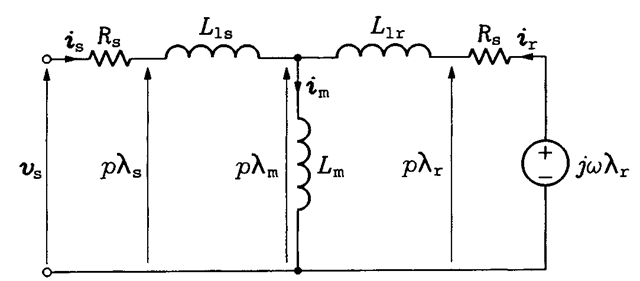6.2
The dynamic T-model of the induction motor in the stator reference frame, with motor variables expressed in the vector form, is shown in Figure
6.3. Symbol p (not to be confused with the number of pole pairs, pp) denotes the differentiation operator, d/dt, while L^, Llp and Lm are the stator and rotor leakage inductances and the magnetizing inductance, respectively (Lls = Xls/co, Lrs = XTJu>, Lm = XJu>). The sum of the stator leakage inductance and magnetizing inductance is called the stator inductance and denoted by Ls. Analogously, the rotor inductance, Lr is defined as the sum of the rotor leakage inductance and magnetizing inductance. Thus, Ls = Ljs + Lm, and Lr = + Lm (Ls = Xs/to, LT = Xr/a>).
The dynamic model allows derivation of the voltage-current equation of the induction motor. Using space vectors, the equation can be written as
![tmp323-37_thumb[1] tmp323-37_thumb[1]](http://lh6.ggpht.com/_X6JnoL0U4BY/S1hyRtwXn2I/AAAAAAAAIQg/v-l1paqYwl4/tmp32337_thumb1_thumb.png?imgmax=800)

FIGURE 6.3 Dynamic T-model of the induction motor.
Symbols /dr and iqT in Eq. (6.9) denote components of the rotor current vector, ir In the squirrel-cage motor, the corresponding components, v^ and vqp of the rotor voltage vector, vv are both zero because the rotor windings are shorted.
The stator and rotor fluxes are related to the stator and rotor current,
as
![tmp323-39_thumb[1] tmp323-39_thumb[1]](http://lh6.ggpht.com/_X6JnoL0U4BY/S1hyVW48lQI/AAAAAAAAIQw/GEZvIV1BvOQ/tmp32339_thumb1_thumb.png?imgmax=800)
The stator flux can also be obtained from the stator voltage and current as
![tmp323-40_thumb[2] tmp323-40_thumb[2]](http://lh3.ggpht.com/_X6JnoL0U4BY/S1hyWbnRpqI/AAAAAAAAIQ4/kxqJ3AraUdU/tmp32340_thumb2_thumb.png?imgmax=800)
while the rotor flux in the squirrel-cage motor satisfies the equation
![tmp323-41_thumb[1] tmp323-41_thumb[1]](http://lh3.ggpht.com/_X6JnoL0U4BY/S1hyXt3kfsI/AAAAAAAAIRA/a6s4G9qb2mE/tmp32341_thumb1_thumb.png?imgmax=800)
Finally, the developed torque can be expressed in several forms, such as
![tmp323-42_thumb[1] tmp323-42_thumb[1]](http://lh3.ggpht.com/_X6JnoL0U4BY/S1hyZoG8kSI/AAAAAAAAIRI/YF-nLRvSbyw/tmp32342_thumb1_thumb.png?imgmax=800)
where the star denotes a conjugate vector.
The rather abstract term Im(is\*) in Eq. (6.17) and the analogous terms in Eqs. (6.18) and (6.19) represent a vector product of the involved space vectors. For instance,
![tmp323-43_thumb[1] tmp323-43_thumb[1]](http://lh3.ggpht.com/_X6JnoL0U4BY/S1hyb71jRhI/AAAAAAAAIRQ/dFMR3GCslgA/tmp32343_thumb1_thumb.png?imgmax=800)
Eq. (6.20) implies that the torque developed in an induction motor is proportional to the product of magnitudes of space vectors of two selected motor variables (two currents, two fluxes, or a current and a flux) and the sine of angle between these two vectors. It can be seen that all the torque equations are nonlinear, as each of them includes a difference of products of two motor variables. Eq. (6.7) is nonlinear, too, because of the variable <o0 appearing in matrix B.
DYNAMIC EQUATIONS OF THE INDUCTION MOTOR
Next post: REVOLVING REFERENCE FRAME (Induction Motor)
Previous post: SPACE VECTORS OF MOTOR VARIABLES (Induction Motor)
